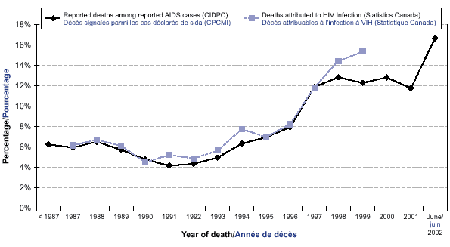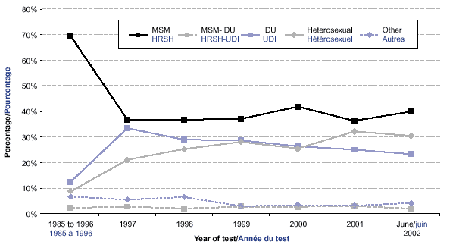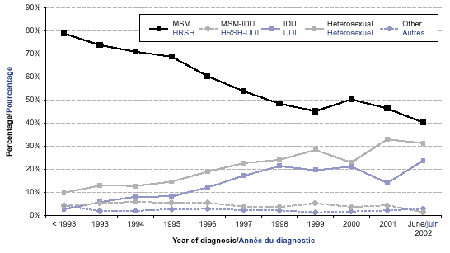Common menu bar links
Institutional links
Diseases & Conditions
Health & Safety
Research & Statistics
Agency Information
Search Box
E-mail this page
HIV and aids in canada
Surveillance Report to June 30, 2002
November 2002
Division of HIV/AIDS Epidemiology and
Surveillance
Centre for Infectious Disease Prevention and Control
Public Health Agency of Canada
HIV and AIDS in
Canada - Surveillance Report to June 30, 2002
69 Pages - (253 KB) 
Information to the readers of HIV and AIDS in Canada
The Division of HIV/AIDS Epidemiology and Surveillance, and the Division Retrovirus Surveillance at the Centre for Infectious Disease Prevention and Control (CIDPC), Health Canada, are pleased to provide you with HIV and AIDS in Canada: Surveillance Report to June 30, 2002.
The Division of HIV/AIDS Epidemiology and Surveillance is responsible for all data analyses, writing and coordination of the publication of this report. This Division works in close collaboration with the Division of Retrovirus Surveillance, which manages the collection of HIV and AIDS surveillance data.
A trend that will be important to monitor in the coming months is the increase observed in the number of positive HIV tests reported to CIDPC in the year 2001 and first half of 2002.
Please note that the number of positive HIV test reports for the province of Quebec is based on the minimum number of HIV positive individuals. Please refer to the Limitations outlined in our Technical Notes section for further explanation.
Since our last edition, several changes have been made to the report to make it more understandable and easier to use. These changes include i) additional tables in a new section entitled Mortality Due to HIV/AIDS in Canada; ii) easy-to-find tabs corresponding to each section of the report; iii) separation of some provincial/territorial data previously combined; and iv) an expanded Technical Notes and Data Limitations section.
A new resource that may be of assistance in the interpretation of this report is entitled, “A Guide to HIV/AIDS Epidemiological and Surveillance Terms”. Epi Updates, which summarize the current status of HIV and AIDS in Canada, are also available, through the Division of HIV/AIDS Epidemiology and Surveillance, on the publication Web site or through the HIV/AIDS Clearinghouse. An address is listed for each on the inside cover of this report. We are continuing to make improvements to this report and always welcome and appreciate your comments and suggestions.
Yours sincerely
| Dana C. Reid, MSc Acting Head HIV/AIDS Surveillance Unit Division of HIV/AIDS Epidemiology and Surveillance |
Jonathan Smith, MSc Senior Surveillance Analyst Division of Retrovirus Surveillance |
Table of Contents
| At a glance | |
| TABLES | |
|
SECTION I |
|
| 1. | Number of positive HIV test reports by year of test (all ages) |
| 2. | Cumulative number of positive HIV test reports occurring in adults and children by gender between November 1, 1985, and June 30, 2002 |
| 3A. | Number of positive HIV test reports by age group and year of test |
| 3B. | Number of positive HIV test reports among males by age group and year of test |
| 3C. | Number of positive HIV test reports among females by age group and year of test |
| 4A. | Number of positive HIV test reports among adults (>= 15 years) by exposure category and year of test |
| 4B. | Number of positive HIV test reports among adult males (>= 15 years) by exposure category and year of test |
| 4C. | Number of positive HIV test reports among adult females (>= 15 years) by exposure category and year of test |
| 4D. | Number of positive HIV test reports among children (< 15 years) by exposure category and year of test |
| 4E. | Number of positive HIV test reports by exposure category and age group between January 1, 2002, and June 30, 2002 |
| 5A. | Number of positive HIV test reports by province/territory and gender between November 1, 1985, and June 30, 2002 (all ages) |
| 5B. | Number of positive HIV test reports by province/territory and year of test (all ages) |
| 6. | Number of positive HIV test reports by exposure category and province/territory between January 1, 2002, and June 30, 2002 (all ages) |
|
SECTION II |
|
|
SECTION III |
|
| 7. | Number of reported AIDS cases by year of diagnosis (all ages) |
| 8. | Cumulative number of reported AIDS cases grouped by age at AIDS diagnosis and gender up to June 30, 2002 |
| 9. | Number of reported adult AIDS cases (>= 15 years) by year of diagnosis and gender |
| 10A. | Number of AIDS cases by age group and year of diagnosis |
| 10B. | Number of male AIDS cases by age group and year of diagnosis |
| 10C. | Number of female AIDS cases by age group and year of diagnosis |
| 11A. | Number and percentage distribution of adult AIDS cases (>= 15 years) by exposure category and year of diagnosis |
| 11B. | Number and percentage distribution of adult male AIDS cases (>= 15 years) by exposure category and year of diagnosis |
| 11C. | Number and percentage distribution of adult female AIDS cases (>= 15 years) by exposure category and year of diagnosis |
| 11D. | Number and percentage distribution of AIDS cases among children (< 15 years) by exposure category and year of diagnosis |
| 11E. | Total number of AIDS cases among adults (>= 15 years), by exposure category and age group up to June 30, 2002 |
| 11F. | Total number of AIDS cases in children (< 15 years) by exposure category and age group up to June 30, 2002 |
| 12A. | Number of AIDS cases (all ages) by province/territory and gender up to June 30, 2002 |
| 12B. | Number of AIDS cases (all ages) by province/territory and year of diagnosis |
| 12C. | Number of male AIDS cases (all ages) by province/territory and year of diagnosis |
| 12D. | Number of female AIDS cases (all ages) by province/territory and year of diagnosis |
| 13. | Number and percentage distribution of AIDS cases (all ages) by province/territory and exposure category to June 30, 2002 |
| 14. | Number of AIDS cases (all ages) by year of diagnosis and ethnic status |
|
SECTION IV |
|
| 15. | Reported deaths among reported AIDS cases and deaths attributed to HIV infection by year of death (all ages) |
| 16A. | Reported deaths among reported AIDS cases among adults (>= 15 years) and children by year of death |
| 16B. | Deaths attributed to HIV infection† among adults (>= 15 years) and children by year of death |
| 17A. | Reported deaths among reported AIDS cases among adults (>= 15 years) by year of death and gender |
| 17B. | Deaths attributed to HIV infection among adults (>= 15 years) by year of death and gender |
|
SECTION V |
|
| APPENDICES Appendix 1. Technical Notes Appendix 2. Data Limitations Appendix 3. Terminology Appendix 4. References Appendix 5. Data Sources |
|
At a Glance 
Introduction
This surveillance report presents HIV and AIDS surveillance data to June 30, 2002, reported to the Centre for Infectious Disease Prevention and Control (CIDPC) from Canadian provinces and territories. This section presents highlights of the main findings in the data through text and figures and is followed by detailed tables with the underlying data.
HIV and AIDS surveillance data, as presented in this report, represent only those individuals who seek testing and/or medical care. The number of positive HIV test reports provides a description of those who came forward for testing, were diagnosed and reported HIV positive. It does not, however, represent the total number of individuals living with HIV (prevalence) or newly infected each year (incidence). Similarly, the number of reported AIDS cases represents those who sought medical care, were given a diagnosis of AIDS and reported to CIDPC. The number of reported AIDS cases, therefore, does not represent true AIDS incidence.
The Division of HIV/AIDS Epidemiology and Surveillance has produced estimates of HIV prevalence to the end of 1999 and HIV incidence in 1999. These estimates were produced using a combination of methods, incorporating data from a wide variety of sources, including positive HIV test reports, AIDS case reports, population-based surveys, targeted epidemiological studies and census data. It was estimated that at the end of 1999 there were approximately 49,800 people in Canada living with HIV (including those living with AIDS) and 4,190 people newly infected with HIV in 1999. Furthermore, of the 49,800, an estimated 15,000 were living with HIV but were unaware that they were infected.
HIV Surveillance Data
There have been 51,470 positive HIV tests reported to CIDPC since HIV testing began in Canada in November 1985. There was nearly a 30% decrease in the number of positive HIV tests reported annually, from 2,987 in 1995 to 2,119 in 2000. However, in 2001, there was a slight increase in this number to 2,180 positive tests reported (Table 1). There have been 1,193 positive HIV tests reported to CIDPC in the first 6 months of 2002, 105 (9.7%) more than at the same time in 2001 (HIV and AIDS in Canada: Surveillance Report to June 30, 2001).
Although the majority of positive HIV test reports among adults continue to be attributed to males, the proportion attributed to females each year has risen. Since 1985, females have accounted for 14.7% of cumulative positive HIV test reports among adults with known gender. Yet, the proportion has increased annually since the reporting of HIV positive test reports began. Females constituted 11.4% of reports among adults in the period between 1985 and 1996, 24.1% in 2000 and 26.0% of reports from January to June 2002 (Tables 3B and 3C). By age group, the proportion of females among adult positive HIV test reports is highest among those aged 15-29 years. This proportion increased from 15.6% in the period between November 1985 and December 1996 to 44.7% in 2001, and then decreased slightly to 42.6% from January to June 2002 (Tables 3B and 3C, Figure 1). The decrease corresponds to an increase in the proportion of positive HIV test reports among males during that 6 month period. Although the proportion of adult reports attributed to young males has been steadily declining, from 84.4% between 1985 and 1996 to 55.3% in 2001, the proportion increased in the first 6 months of 2002 to 57.4%.
As shown in Figure 2, the proportion of adult positive HIV test reports attributed to injecting drug use has continued its gradual decline into the first 6 months of this year, down to 23.3% from a high of 33.5% in 1997. The proportion among the heterosexual exposure category1 increased steadily from 9.1% in 1985-1996 to a high of 32.4% in 2001, and has decreased to 30.6% between January and June of this year. The decrease in proportions attributed to injecting drug use (IDU) and heterosexual transmission has, in large part, been taken up by the exposure category men who have had sex with men (MSM). After a decrease in 2001 to 36.4% of adult positive HIV test reports, this figure increased to 40.0% in the first half of 2002 (Table 4A, Figure 2).
AIDS Surveillance Data
Since the beginning of the epidemic in the early 1980s, there have been 18,336 AIDS cases reported to CIDPC (Table 7).
Females account for 8.4% of the total cumulative reported AIDS cases up to June 30, 2002, for which age and gender were reported. Among reported adult AIDS cases, the proportion of females increased from 5.8% during the period 1979-1993 to 15.1% in 2001. The proportion has since increased to 16.7% in the first 6 months of 2002 (Table 9). The age group in which females make up the largest proportion of adult AIDS cases is 15-29 years. The proportion of females among reported AIDS cases in this age group rose from 9.7% (182/1,877) before 1993 to 47.4% (9/19) in 2001. The proportion was 42.9% (3/7) between January and June 2002, although the sample for this year is incomplete. When considering these changing proportions, it is important to note that the number of reported AIDS cases has declined substantially since the beginning of the epidemic (Tables 10B and 10C).
The proportion of reported adult AIDS cases attributed to the heterosexual exposure category increased to 28.4% in 1999, dropped to 22.9% in 2000 and increased to 33.0% in 2001. In the first half of 2002, this proportion has dropped again, to 31.3%, but still remains higher than that reported in 1999. The proportion of reported adult AIDS cases among MSM steadily declined over the last decade, to 45.2% in 1999; it increased in 2000 to 50.4%, and then declined to 46.4% in 2001. Another decline has occurred between January and June 2002, with MSM accounting for 40.3%, the lowest since the beginning of the epidemic. A steady rise in the proportion of IDU, from 2.7% in the period between 1979 and 1993 to 21.5% in 1998, was followed by a leveling off until a decline was seen in 2001, to 14.1% of all reported adult AIDS cases. There has, however, been an increase in the first half of this year, with IDU representing 23.9% of reported AIDS cases among adults (Table 11A, Figure 3).
As outlined in Figure 4, the proportion of reported AIDS cases among Whites has decreased from 87.5% before 1993 to 64.1% in the first 6 months of 2002. The proportion of reported AIDS cases attributed to Blacks increased from 7.9% prior to 1993 to 15.0% in 1999, then dropped to 10.2% in 2000, rising again to 15.6% since January of this year. The most notable change in the last 6 months has been the change in the number of reported AIDS cases among Aboriginal groups. This increased from 1.4% between 1979 and 1992 to 10.0% in 1999, decreased to 5.3% in 2001, and then rose again to 14.1% for the current reporting period.
HIV/AIDS Mortality Data
In Canada, there are two sources of national information on the number of deaths due to HIV/AIDS: CIDPC, which publishes data on reported deaths among reported AIDS cases, and the Health Statistics Division of Statistics Canada, which collects data on all deaths, including those attributed to HIV infection.
The first reported death due to HIV/AIDS was the death of a reported AIDS case in 1980. The number of such deaths increased from the beginning of record keeping to 1995, as did deaths attributed to HIV infection. In 1995, the number of deaths reported were 1,477 and 1,764 respectively. Both sources show a dramatic decrease in deaths since that time (Table 15). Both also show an increase over time in the proportion of females among recorded deaths, consistent with the rising proportion over time of females among HIV/AIDS cases (Figure 5). Please see Section IV for more details on the respective advantages and limitations of the two sources noted above.
Interpretation
It is important to be cautious when interpreting the surveillance data for the first half of the reporting year because of small samples, delayed reporting and underreporting. CIDPC will continue to monitor the surveillance data and will clarify whether these findings are sustained when data for the full year are reported.

1 Note: Heterosexual exposure category includes three subcategories: sexual contact with a person at risk, origin from a pattern II country and sex with the opposite gender as the only identified risk (NIR-HET).




